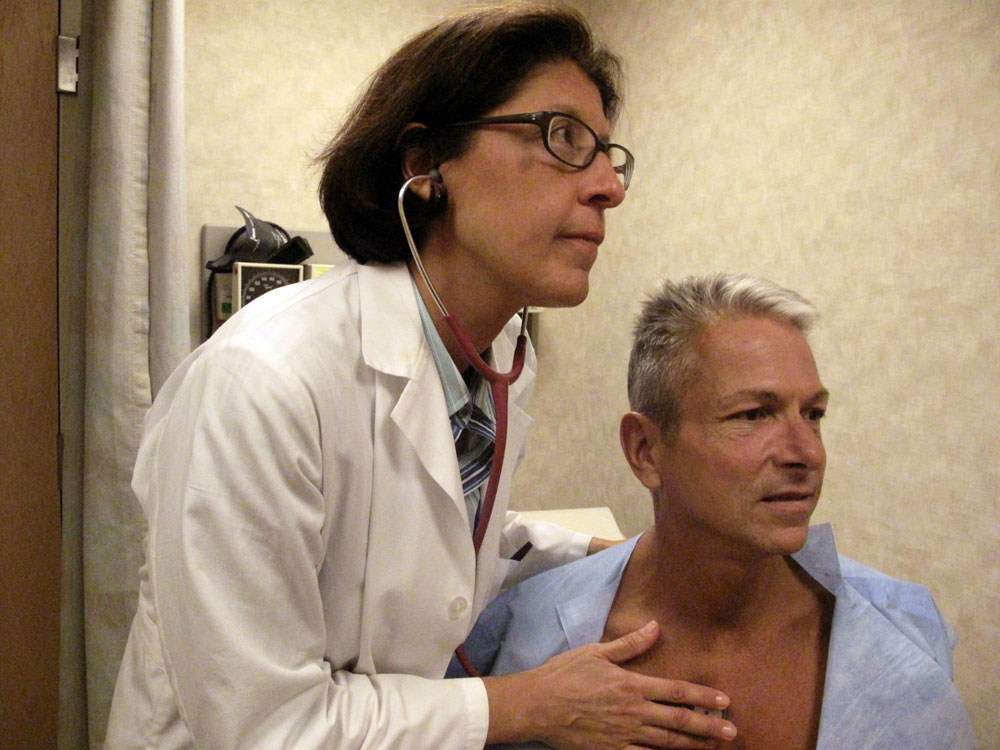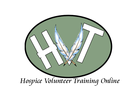Cancer patients who have dis-enrolled from hospice services are more likely to go to the emergency room or remain longer in the hospital than
Thursday, September 23, 2010
Tuesday, September 21, 2010
Parents Aging, Squabbling Adult Siblings Need Elder Mediation, Conflict Resolution - AARP Bulletin

Good article on
http://www.aarp.org/relationships/family/info-09-2010/elder_mediation.html
Maybe we can help more families assist with "staying" family with stronger education. Mediation - new buzz word?
Monday, September 20, 2010
The Fading Art Of The Physical Exam : NPR

Internist Nesli Basgoz examines patient Barry Arcangeli who has a leaky heart valve. Basgoz discovered Arcangeli's heart condition during a routine physical examination.

Internist Nesli Basgoz examines patient Barry Arcangeli who has a leaky heart valve. Basgoz discovered Arcangeli's heart condition during a routine physical examination.
For centuries, doctors diagnosed illness using their own senses, by poking, prodding, looking, listening. From these observations, a skilled doctor can make amazingly accurate inferences about what ails the patient.
Technology has changed that. "We're now often doing expensive tests, where in the past a physical exam would have given you the same information," says Jason Wasfy, a cardiologist-in-training at Massachusetts General Hospital in Boston.
As a result, many doctors are abbreviating the time-honored physical exam — or even skipping it altogether.
Some Patients Never Examined
"It's amazing to me that in this day and age there are some patients who go to their doctor, and the doctor doesn't even examine them," says Roman DeSanctis, a senior cardiologist at Massachusetts General Hospital who is famous for his diagnostic skills.
"I sometimes joke that if you come to our hospital missing a finger, no one will believe you until we get a CAT scan, an MRI and an orthopedic consult. We just don't trust our senses."
- Dr. Abraham Verghese
DeSanctis says he recently listened to one patient's chest and heard the unmistakable sounds of abnormal fluid buildup. It turned out he had lung cancer.
"I said, 'Did Dr. So-and-so mention anything about this when he saw you?' " DeSanctis says. "And he said, 'Well, he took my blood pressure, but he didn't really examine me.' This is not an isolated case."
And it appears that the trend is likely to get worse. "I'm definitely worried that the physical exam is dying a slow death," says Nesli Basgoz, a physician at Massachusetts General Hospital.
She reports that young trainees often ask her why they need to learn the subtle and hard-won skills needed to do a good physical exam.
"They say, 'If it's so important, how come we sit around in a conference room and talk about what's in the chart, instead of spending more time seeing patients?' " Basgoz says.
Basgoz is trying to buck the trend — in her teaching and by setting a good example.
Careful Exam Crucial
To illustrate how important a thorough physical can be, she introduces patient Barry Arcangeli, a 50-year-old man with a leaky aortic valve.
Arcangeli's heart murmur "is loud and it's long," Basgoz says, offering the patient and a visitor the chance to listen for themselves. "Do you hear it?" she says. "It goes 'whooo-whooo.' That 'whooo' sound shouldn't be there at all."
Arcangeli has no heart symptoms, so his leaky valve would probably not have been picked up if Basgoz hadn't noticed it during a routine physical exam. She says at some point he'll probably need a new heart valve, but meanwhile he needs careful monitoring and preventive treatment.
Even when doctors go through the motions of doing a physical, their diagnostic skills aren't what they used to be. One recent study in the Journal of the American Medical Association examined stethoscope skills of various kinds among 453 practicing physicians and 88 medical students. Whatever their age or experience, the doctors correctly recognized only 20 percent of heart problems.
At Stanford Medical School, professor Abraham Verghese is leading the charge to restore the physical exam to what he considers its rightful place, and bring doctors' skill up to snuff.
"I sometimes joke that if you come to our hospital missing a finger, no one will believe you until we get a CAT scan, an MRI and an orthopedic consult," Verghese says. "We just don't trust our senses."
Verghese says it's as though the output of machines is the only information that counts.
"You know, we often spend so much time with that entity in the computer — I call it the 'iPatient,' like your iPad and your iPhone. And the real patient in the bed is often left wondering, 'Where is everybody? What are they doing?' I sense that we're spending very little time at the bedside."
Stanford 25
Stanford Medical School in California is trying to make sure its graduates and trainees know how to do 25 bedside tests that it considers essential to good doctoring.
Here's the list:
- Examine the back of the eye
- Examine the pupil of the eye and its response to light
- Examine the thyroid gland
- Examine the neck veins for abnormal size and pulses
- Examine the lung's surface, lung sounds and borders
- Evaluate the heart's motion
- Examine the liver's size and shape
- Evaluate the spleen's size and density
- Evaluate gait (walking movements)
- Test ankle reflexes for nerve abnormalities
- Identify markers of liver disease throughout the body
- Identify signs of stroke caused by blockage of a deep brain artery
- Examine the knee
- Identify abnormal heart sounds
- Evaluate tremors and other involuntary movements
- Recognize markers of disease in the hands and fingernails
- Examine the tongue
- Examine the shoulder for injuries and joint abnormalities
- Assess blood pressure and abnormal pulses
- Assess lymph nodes in the neck
- Detect fluid in the abdomen and abdominal blood flow
- Perform a rectal exam
- Evaluate a mass in the scrotum
- Test balance and ability to perceive the body's position in space
- Use a pocket ultrasound device*
*This item is not yet standard practice in most U.S. medical settings, but Dr. Abraham Verghese of Stanford hopes it will be. He says it's valuable in detecting abnormal fluids, quickly evaluating heart function and assessing organ abnormalities
--Richard Knox
Reversing The Trend
At Stanford, they're trying to reverse the trend. The school's graduates and trainees have to master 25 different bedside exam skills, from palpating a spleen to testing ankle reflexes. (See accompanying sidebar)
Verghese is convinced that doctors who know how to do a competent physical will pick up a lot of serious problems. "My worst nightmare," he says, "is that someone passes through my hands with a diagnosable, treatable condition that I missed because of sloppy technique. And they pop up six months later with somebody else at a point when it's not treatable."
But some critics consider Verghese an incurable romantic.
"I don't believe that trying to resurrect the physical exam of yore is the right use of the increasingly scarce time we have with our trainees," says Bob Wachter, a professor and chief of the Division of Hospital Medicine at the University of California, San Francisco. "And some of the time the physical exam doesn't stand up very well against some of the other tests that we have. It's just not accurate enough."
Wachter says it's more important to spend the time talking to the patient and answering questions than percussing, palpating, peering into eyes and ears, tapping on knees and doing all of the other things in the classic physical.
But Verghese says there's another important reason to do physical diagnosis: Patients miss the laying on of hands.
The Importance Of Touch
"I always listen to language very carefully when people complain about us –- and they complain a lot," the Stanford internist says. "And if you listen to the words people use, it's very often, 'He or she never laid a hand on me, he or she never touched me, he or she was hardly listening and they were busy entering stuff into the computer.' "
Verghese says before doctors dispense with the physical exam they should think about what's really happening during the encounter.
"If you look at the physician exam –- one individual coming to another, telling them things they would not tell their spouse or rabbi or priests, and then, incredibly, disrobing and allowing touch," Verghese says. "I think our skills in examining a patient have to be worthy of that kind of trust."
And the full ritual is necessary, he says, to establish that connection.
Related NPR Stories
More Science

Shots - Health News Blog
Weird Facts About Genetically Engineered Salmon
The engineered fish are sterile, have three sets of chromosomes and are exclusively female.

Your Health
Human Connections Start With A Friendly Touch
A simple, supportive touch leads to a surge of positive-feeling events in the brain and body.

Science
The Fading Art Of The Physical Exam
As high-tech medical tests increase, some doctors say the art of the physical exam is being lost.
Comments
Please note that all comments must adhere to the NPR.org discussion rules and terms of use. See also the Community FAQ.
You must be logged in to leave a comment. Login / Register
More information is required for you to participate in the NPR online community. Add this information
NPR reserves the right to read on the air and/or publish on its Web site or in any medium now known or unknown the e-mails and letters that we receive. We may edit them for clarity or brevity and identify authors by name and location. For additional information, please consult our Terms of Use.
I believe just the touch can often make a difference, and the optimal treatment begins with instinct by the doctor and the patient.
Hospice Volunteer Coordinators - Train Volunteers Online
Volunteer Training Online
Those who have started the course in the past couple of years have agreed that it is a great start to their venture into palliative care
Hospice Hearts and Cardiology
I ran across an article this morning that I found a few months ago.
Like a memorable song, the content plays in your head and you forget it. Later when it reappears you remember what a great song it was. So it was with this article.
Donald P. Copley, M.D., a cardiologist wrote about the benefits
Sunday, September 19, 2010
YouTube - HIPAA - Easy
Adding HIPAA information to the volunteer training program has proved quite daunting.
I have researched the OCR and HHS sites and





